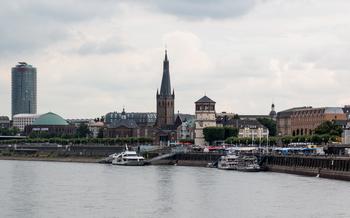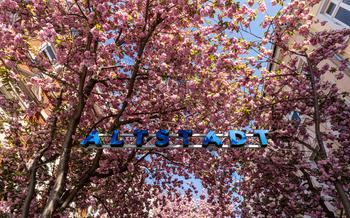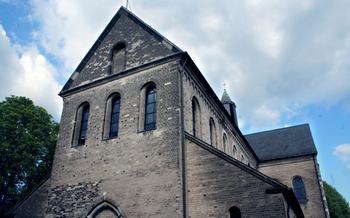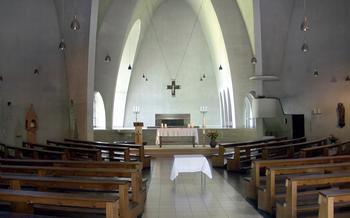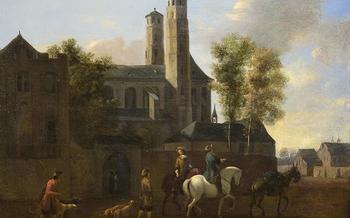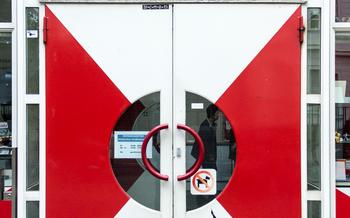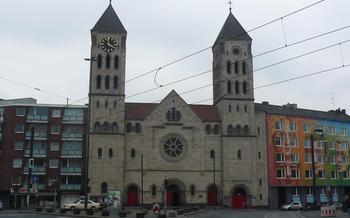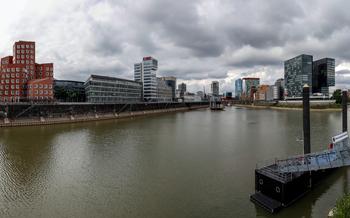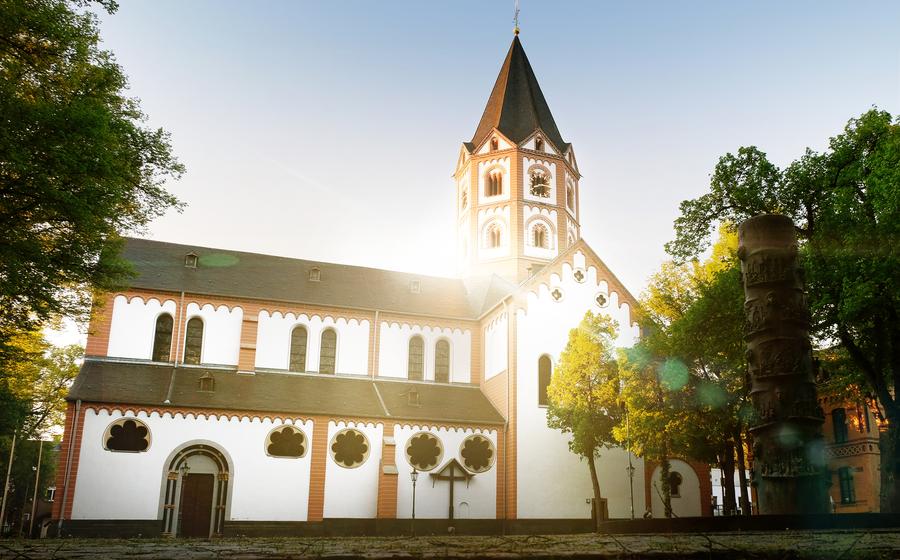
St. Margareta Church
- Historical Significance:
- Architectural Masterpiece
- Interior Beauty
- Religious Significance
- Cultural Events
- Guided Tours
- Accessibility
- Photography and Videography
- Dress Code
- Respectful Behavior
- Local Legends and Stories
- Nearby Attractions
- Souvenirs and Gifts
- Insider Tip: Discover the Hidden Courtyard
Historical Significance:
St. Margareta Church stands as a testament to Düsseldorf's rich history, its origins tracing back to the 13th century. Nestled in the heart of the Altstadt (Old Town), this Gothic masterpiece has witnessed centuries of transformation, serving as a beacon of faith and resilience. Remarkably, it has endured numerous wars and renovations, emerging each time with renewed splendor. Today, it stands protected as a historical monument, a symbol of Düsseldorf's enduring spirit.
Architectural Masterpiece
St. Margareta Church stands as a testament to the exquisite craftsmanship and architectural ingenuity of the medieval era. Its Gothic facade, with its intricate carvings and pointed arches, draws the eye upward, creating a sense of awe and wonder. The church's unique blend of Romanesque and Gothic elements, evident in its rounded arches and ribbed vaulting, showcases the transition between two distinct architectural styles. The towering spire, reaching towards the heavens, offers breathtaking panoramic views of the city, making it a popular destination for visitors seeking a bird's-eye perspective of Düsseldorf.
Over the centuries, the church has undergone meticulous restoration efforts, ensuring that its architectural integrity and grandeur are preserved for generations to come. These renovations have not only maintained the church's original splendor but have also contributed to its enduring status as a beloved landmark and a symbol of Düsseldorf's rich cultural heritage.
Interior Beauty
St. Margareta Church's interior is a testament to the craftsmanship and artistry of the Gothic era. Upon entering, visitors are greeted by a breathtaking expanse of vaulted ceilings that soar high above, creating a sense of awe and grandeur. The intricate ribbed vaults, supported by slender columns, converge at ornate keystones, each adorned with unique carvings and symbols.
The church's stained-glass windows are a symphony of color and light, casting a radiant glow upon the interior. These exquisite windows depict scenes from the Bible, the lives of saints, and the history of Düsseldorf. The vibrant hues and intricate details bring these stories to life, inviting visitors to contemplate their deeper meanings and symbolism.
Intricate carvings and sculptures adorn every corner of the church, adding to its visual splendor. From the finely crafted pulpit to the delicate tracery of the choir stalls, each piece of artwork is a testament to the skill and dedication of the medieval artisans who created them.
The church's impressive organ, a masterpiece of craftsmanship, occupies a prominent position in the rear gallery. With its gilded pipes and intricate carvings, this magnificent instrument fills the church with its majestic sounds during religious services and concerts, captivating audiences with its rich tones and harmonies.
Religious Significance
St. Margareta Church holds immense religious significance in Düsseldorf, serving as a spiritual hub for the local Catholic community. The church is dedicated to St. Margareta, a revered saint closely associated with the city. Her patronage symbolizes strength, faith, and protection, inspiring many believers. Throughout the year, the church hosts various religious ceremonies and events, including traditional masses, special services, and festivals. These gatherings foster a sense of community and provide a space for spiritual reflection and worship. The church's dedication to preserving Catholic traditions and promoting spiritual growth makes it a cherished part of Düsseldorf's religious landscape.
Cultural Events
St. Margareta Church is not merely a religious site but also a vibrant cultural hub that hosts a diverse range of cultural events and concerts. The church's exceptional acoustics, created by its vaulted ceilings and intricate architecture, make it an ideal venue for musical performances. Visitors can enjoy classical concerts, organ recitals, and choral performances that showcase the talents of local and international musicians.
Moreover, the church regularly organizes cultural events that promote cross-cultural understanding and exchange. These events may include art exhibitions, film screenings, and lectures on various topics related to art, history, and religion. The church's commitment to cultural enrichment makes it a beloved destination for art enthusiasts and those seeking a deeper connection with the local community.
Guided Tours
St. Margareta Church offers guided tours that provide visitors with an in-depth exploration of its history, architecture, and religious significance. These tours are conducted by knowledgeable guides who share fascinating insights and anecdotes about the church, bringing its rich past to life. Visitors can choose from regular tours, which are available in multiple languages, or specialized tours designed for groups with specific interests.
During the guided tours, visitors will learn about the church's origins in the 13th century and its remarkable survival through numerous wars and renovations. They will admire the intricate Gothic architecture, including the stunning facade, vaulted ceilings, and stained-glass windows, and discover the symbolism and stories behind these artistic masterpieces. The guides will also explain the church's role as a center of Catholic worship in Düsseldorf and its importance to the local community.
To ensure a spot on a guided tour, it is advisable to book in advance, especially for groups. Visitors can make reservations online or through the church office. Guided tours offer a unique opportunity to delve deeper into the history and significance of St. Margareta Church, making them a must-do for anyone interested in exploring Düsseldorf's cultural and religious heritage.
Accessibility
St. Margareta Church is easily accessible by public transportation. The nearest U-Bahn (metro) station is Heinrich-Heine-Allee, which is just a short walk from the church. Several bus lines also stop nearby, including lines 705, 707, and 70
For those arriving by car, there are several parking options available. The closest parking garage is the Heinrich-Heine-Garage, which is located just across the street from the church. There are also several on-street parking spaces in the surrounding area, but these can be limited, especially during peak tourist season.
The church is open to visitors daily from 10:00 am to 6:00 pm. Admission is free of charge. Guided tours are available in multiple languages and can be booked in advance through the church office.
The church is wheelchair accessible, and there is a ramp leading up to the main entrance. There are also accessible restrooms available inside the church.
Overall, St. Margareta Church is a very accessible attraction for visitors of all abilities. Whether you are arriving by public transportation, car, or on foot, you will have no trouble reaching the church and enjoying its many wonders.
Photography and Videography
St. Margareta Church welcomes visitors to capture the beauty of its interior through photography and videography. However, to maintain the sacred atmosphere and respect the privacy of others, certain guidelines must be followed.
Photography and videography are permitted for personal, non-commercial purposes only. Professional photography or videography requires prior permission from the church administration.
Visitors are asked to be mindful of other visitors who may be praying or attending a religious service. Flash photography and tripods are not allowed.
When taking photos or videos, visitors should focus on the architectural features and artwork of the church. It is important to avoid capturing images of individuals without their consent.
For those interested in capturing the church's exterior, alternative locations may provide better angles and lighting. The surrounding streets and nearby parks offer picturesque views of the church's facade and towers.
Dress Code
St. Margareta Church, as a sacred space dedicated to worship and reverence, adheres to a modest dress code. Visitors are expected to dress respectfully, ensuring that their attire aligns with the church's solemn atmosphere. While the church welcomes all visitors, regardless of their religious beliefs, it is essential to maintain decorum and be mindful of the religious significance of the place.
When visiting St. Margareta Church, it is advisable to avoid revealing or overly casual clothing. Shorts, tank tops, and flip-flops are generally considered inappropriate. Instead, opt for clothing that covers your shoulders and knees. For women, a skirt or dress that falls below the knee and a blouse or sweater that covers the shoulders are appropriate choices. Men should wear long pants and a shirt or polo shirt.
If you happen to be wearing sleeveless clothing, it is considerate to bring a scarf or shawl to cover your shoulders while inside the church. This simple gesture shows respect for the sacred space and the feelings of other visitors.
By dressing appropriately, visitors can contribute to the respectful and serene atmosphere of St. Margareta Church, allowing everyone to fully immerse themselves in its spiritual and historical significance.
Respectful Behavior
St. Margareta Church is not just a historical landmark but also an active place of worship for the local Catholic community. It is essential to show respect and reverence while visiting the church, whether you are a religious person or not.
Upon entering the church, maintain silence and avoid disruptive behavior. This includes refraining from loud conversations, using mobile phones, or engaging in activities that may disturb others. Be mindful of other visitors who may be praying or attending a religious service. If you need to speak, do so quietly and respectfully.
Remember that the church is a sacred space, and your behavior should reflect that. Dress modestly and avoid wearing revealing or casual attire. If you are wearing sleeveless clothing, consider bringing a scarf or shawl to cover your shoulders.
Be respectful of the church's property and artwork. Do not touch or lean against the statues, paintings, or other religious objects. If you have any questions or need assistance, approach a member of the church staff or a volunteer. They will be happy to help you and provide more information about the church.
By following these guidelines, you can ensure that everyone has a peaceful and meaningful experience while visiting St. Margareta Church.
Local Legends and Stories
St. Margareta Church is steeped in local legends and stories that have been passed down through generations. One of the most famous legends tells the tale of a young woman named Margareta who was martyred for her Christian faith. According to legend, she was beheaded by a Roman governor after refusing to renounce her beliefs. Her body was then thrown into the Rhine River, but miraculously washed ashore at the site where the church now stands.
Another legend associated with the church is the story of the "Düsseldorf Dragon." This mythical creature is said to have terrorized the city in the Middle Ages, until it was slain by a brave knight named Georg. According to legend, the dragon's blood stained the ground where the church now stands, giving the area its name, "Drakensang" (Dragon's Blood).
These legends and stories have played a significant role in shaping the history and reputation of St. Margareta Church. They have also helped to create a sense of mystery and intrigue around the church, making it a popular destination for both tourists and locals alike.
Nearby Attractions
St. Margareta Church is conveniently located near several other notable attractions in Düsseldorf's Altstadt. Just a short walk away, visitors can explore the Marktplatz, the historic central square of the city. Here, they can admire the Rathaus (City Hall), with its Renaissance-style architecture and ornate facade, and the Schlossturm (Castle Tower), a remnant of the former Düsseldorf Castle.
Another nearby attraction is the Rheinuferpromenade (Rhine Promenade), a scenic walkway along the banks of the Rhine River. Visitors can stroll along the promenade, enjoying panoramic views of the river and the city skyline. Along the way, they can stop at one of the many cafes or restaurants to relax and take in the atmosphere.
For art enthusiasts, the Kunstpalast Museum is a must-visit. This renowned museum houses an extensive collection of paintings, sculptures, and decorative arts from the Middle Ages to the present day. Visitors can admire works by famous artists such as Rubens, Rembrandt, and Monet, as well as contemporary pieces by international artists.
To combine a visit to St. Margareta Church with these other attractions, visitors can create a walking itinerary that allows them to explore the area at their own pace. The close proximity of these attractions makes it easy to hop from one to another, ensuring a full and memorable experience in Düsseldorf's Altstadt.
Souvenirs and Gifts
As a memento of your visit to St. Margareta Church, consider purchasing a souvenir or gift to remember this special experience. The church gift shop offers a variety of items, including postcards, books, and religious artifacts. You can also find souvenirs in nearby stores and shops, where you'll discover a range of unique items inspired by the church and its history. These souvenirs make for thoughtful gifts for friends and family, allowing them to share in your pilgrimage or appreciation for this magnificent landmark.
Insider Tip: Discover the Hidden Courtyard
Venture beyond the main entrance of St. Margareta Church to uncover a hidden gem – a serene courtyard nestled amidst the bustling city. This tranquil oasis offers a moment of respite from the vibrant streets, inviting visitors to pause and reflect. Surrounded by ancient stone walls and adorned with delicate flowers, the courtyard exudes a sense of peace and tranquility. Take a seat on one of the benches and soak in the serene atmosphere, allowing the beauty of the surroundings to wash away the stresses of everyday life. This hidden courtyard is a testament to the church's rich history, providing a glimpse into its hidden depths and offering a unique perspective on this architectural masterpiece.
